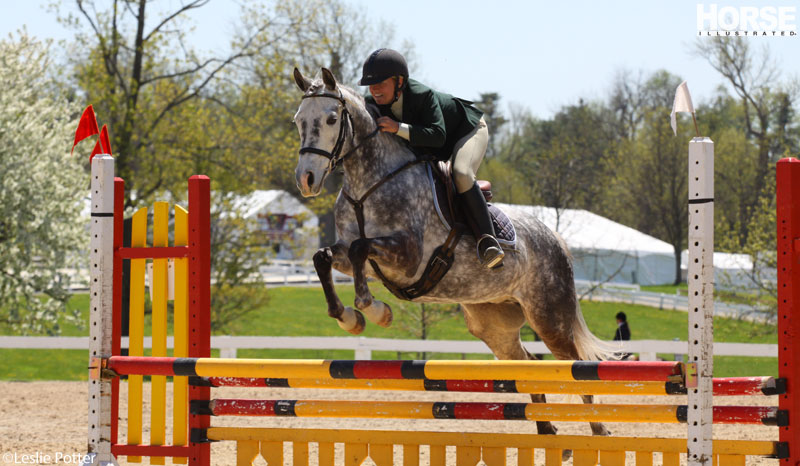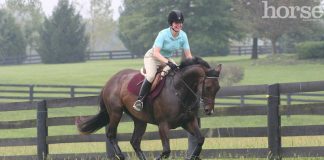
Q. I currently ride my 10-year-old gelding in jumper classes. He is very smart and a beautiful jumper, but he is also very sensitive. When we come up to a fence, he gets kind of strong, so I tense up and grip, causing him to rush and leap over the jump. I have been told millions of times to relax. Any suggestions or exercises to help me?
Don’t make the common mistake of standing up in your stirrups and throwing your upper body onto the horse’s neck in two-point. Instead, think of bending your upper body forward from your hips, staying close to the tack. In a proper two-point, your hips remain centered over your low heels. While you’re building the thigh and back muscles you need to hold this position securely, grab the horse’s mane for support.
When you’re ready to jump again, use ground poles to help your horse meet jumps correctly and discourage his tendency to overjump. Set three trotting rails, 4 to 5 feet apart, and practice trotting these calmly, back and forth; hold your two-point and grab the mane over the rails, then resume posting trot.
Now add a small cross-rail, about 6 to 8 feet after the rails, followed by a landing rail 6 to 8 feet after the jump. (Adjust all distances to suit the size of your horse.) Post the trot to the exercise, then quietly assume the two-point position and grab your horse’s mane over the rails, the little jump and the landing rails. Look straight between your horse’s ears and try not to let your position change throughout the exercise.
As you practice this repeatedly, you’ll gain a sense of how it feels to follow your horse in the air through the jump. The ground rails should slow your horse down and encourage him to hold a steady rhythm to the jump; the landing rail will make him put his feet down promptly after the jump instead of leaping extravagantly beyond the fence.
As the two of you gain confidence together, you’ll both relax. Your horse will know that you won’t grab him in the mouth (because you’re holding that mane), and you’ll begin to feel secure in the tack over the jump.
Liked this article? Here are others you’ll enjoy:
Rider Fear: Get Your Head Together
End Horse Show Nerves
Horse Jumping Tips
Annie Eldridge is an event rider who trains out of her Setters’ Run Farm in Duxbury, Mass.






Thanks for this article. I have the same problem. The horse I ride likes a lot of give and take with the reins. As I’m sure all horses do. And come the jump, she begins to speed up and I tense up because I’m trying very hard to slow her pace down so she won’t rush to and over the fence. Thank you for this article. It might be my confidence over the jump that might be at fault. I’ll be practicing a lot of two point at my next lesson. I always do, but maybe if I stick with it for longer, it might give me some major progress. Thanks again!
Practice, practice, and more practice, start slow and low.
I was worried about position too but then I noticed that when I jump if I just stood in the stirrups my horse would put me in the right position. A smooth jump feels like flying! I’m addicted!